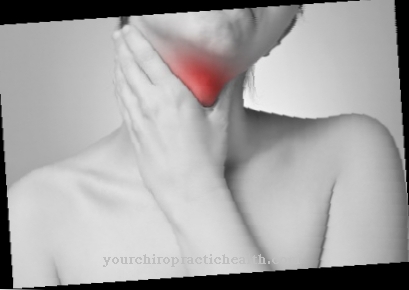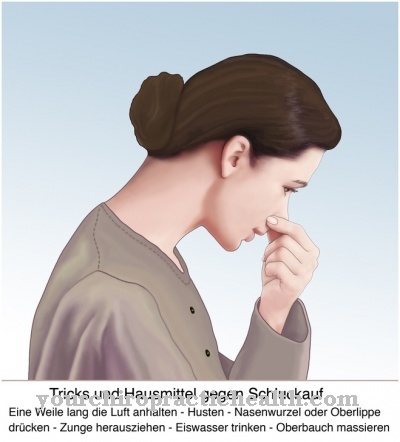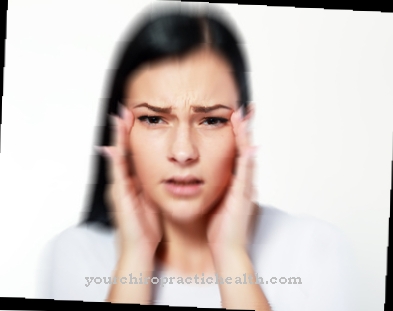Discharge from the ear is not only very uncomfortable, it can also be accompanied by severe pain in the ear canal. Often the reason is an inflammation in the ear canal, which can have various causes and always requires medical treatment. To do this, the doctor must first find the cause of the discharge from the ear.
What is discharge from the ear?

The acute discharge of secretions from the ear canal through the auricle is called discharge from the ear. The fluid runs out of the ear by itself through the ear canal, in very bad cases the secretion also drips onto clothing, which can be very uncomfortable for the patient.
This discharge from the ear can be purulent or even bloody and always indicates a pathological inflammation of the ear or eardrum. Affected people usually also have severe pain in the ear and are impaired by other symptoms such as fever or dizziness.
The discharge from the ear can be very uncomfortable for the patient in the long run, because the discharge of secretions often causes tickling in the ear, which can be an enormous burden.
causes
Discharge from the ear is often caused by inflammation in the inner ear. This can be an inflammation of the ear canal, in which the inflamed skin of the ear canal gives off secretions, or it can be inflammation of the middle ear (otitis media), in which fluid is secreted from a hole in the eardrum.
While ear canal inflammation often results from manipulation of the ear canal and subsequent penetration of pathogens into injured areas, otitis media has bacterial causes that cause the symptoms.
Both types of inflammation can usually be very painful and regularly cause additional symptoms. In addition to the discharge from the ear, general exhaustion, fever, (stabbing) pressure in the ears, reduced hearing as well as dizziness and balance disorders can also occur.
You can find your medication here
➔ Medicines for earache and inflammationDiseases with this symptom
- Otitis media
- Ear flow (otorrhea)
- Ear infection
Diagnosis & course
In the case of discharge from the ears and ear pain, a doctor should always be consulted so that a diagnosis can be made. Otherwise, untreated ear infections can, in the worst case, take a chronic course and affect the patient's life.
A number of exams and tests are available to help make a diagnosis. The doctor will first clarify which symptoms are present in a conversation. He will then take a closer look at the ear canal through an otoscopy, using an ear speculum to examine the inner ear optically. Inflammation caused by reddening or a bulging of the eardrum is often clearly visible.
As a rule, a hearing test is also carried out to measure hearing, which can be important for monitoring the progress. If necessary, the doctor can do further tests to check how flexible the eardrum is and how well the Eustachian tube is working.
Complications
Discharge from the ear is not only uncomfortable, it can also be caused by a serious illness. Most often it's an inflammation of the ear canal, but the doctor needs to find the exact cause. Discharge from the ear is a secretion that is transported out through the ear canal via the auricle.
The discharge can even be bloody or purulent and always indicates an inflammation of the eardrum or ear. This discharge is accompanied by severe pain and patients often suffer from dizziness or fever. The discharge from the ear is always uncomfortable for the patient, even if there are no side effects. Because the drainage of secretions causes a tingling sensation in the ear and often the liquid does not smell good.
The inner ear has often become infected and can be treated quickly with ear drops. Above all, the ear drops should be administered at night, because earaches in particular intensify many times over at night. This is to relieve the pain and at the same time lower the fever.If the infection is bacterial, antibiotics are used and, in an emergency, the doctor can also rinse the ear to reduce the bacteria and clean the ear. If secretion has already settled on the eardrum, a puncture is made and the secretion is suctioned off. The patient will quickly feel pain relief and the pressure in the ear will be significantly reduced. The patient hears better again. In addition, ear drops are given and infrared light promotes healing.
When should you go to the doctor?
Discharge from the ear may be an overproduction of lard. If it is not chronic, this usually does not need to be clarified by a doctor.
However, it can be helpful to have an ear, nose and throat specialist clean your ear. This is especially true when it comes to impaired hearing. In some cases the ear is unable to clean itself. A visit to the doctor can relieve symptoms and improve hearing.
If the discharge is green and smells unpleasant, there is an infection with bacteria. This must be presented to an ear, nose and throat specialist as soon as possible. The earlier therapy begins, the lower the likelihood of irreversible damage to the inner ear. If a bacterial ear infection with discharge is not treated in time, it can spread to the auditory bones and destroy them.
You must also see a doctor if the discharge from the ear is painful or if there is bloody discharge from the ear. There could be an internal injury to the ear. The family doctor can make the first diagnosis here. Under certain circumstances, they will recommend a further examination by the ear, nose and throat specialist.
Doctors & therapists in your area
Treatment & Therapy
Treatment for discharge from the ear depends on the cause. In the first place in the treatment of all ear infections there are always decongestant ear drops, so that the secretion is not prevented from flowing away by swollen mucous membranes.
Certain pain relievers can be given to reduce pain. Above all, these should make the nights painless, because ear pain usually intensifies many times over during the night. These pain relievers are also used as antipyretic agents. If the infection is bacterial, an otitis media, which is causing discharge from the ear, antibiotics are used to treat it. The doctor may also rinse the ear to cleanse the ear and reduce the bacterial density. This can speed up the healing process.
If a lot of secretion has accumulated behind the eardrum, a puncture is an option. The eardrum is punctured and the secretion is sucked off. The patient receives pain relief because the pressure in the ear is reduced. This measure also improves hearing. Ear drops can also be administered. Irradiation with red light relieves pain and promotes healing.
Outlook & forecast
Discharge from the ear can be caused by several things. Accordingly, the prognosis and course of this complaint also vary.
In the case of transparent discharge from the ear caused by inflammation, the discharge decreases at the same time as the itchiness and disappears after a short time. If a bacterial infection occurs during a simple inflammation, the discharge can begin to turn green and smell bad.
If such a bacterial inflammation persists for a long time, it can lead to a chronic course. This has the consequence that the outflows can become permanent. In addition to the discharge, severe impairment of hearing can then occur. Increased tiredness can also develop in the course of chronic inflammation in the ear canal. Discharge from the ear can also become purulent and bloody as the inflammation progresses. In almost every case, this indicates that the inflammation has spread to deeper areas of the ear, sometimes to the eardrum.
If the discharge does not end despite appropriate therapy, it could also be an anatomically related problem. Some deformities in the hearing apparatus can lead to constant discharge. These can then only be remedied with an operation.
You can find your medication here
➔ Medicines for earache and inflammationprevention
Discharge from the ear or the diseases causing it can be prevented.
All manipulation of the ear canal should be avoided, e.g. inserting cotton swabs into the ear canal for cleaning. Vaccines that are recommended for children are available against the pathogens causing otitis media.
If the patient is known to suffer from damage to the eardrum, avoid allowing water to enter the ear, for example when showering or swimming. If children often suffer from otitis media, the use of ventilation tubes and the removal of the tonsils can be considered.
You can do that yourself
Discharge from the ear usually indicates inflammation in the inner ear. Anyone who suffers from such an inflammation in the ear should pay attention to thorough cleaning. Otherwise there is a risk of a significant deterioration. The ear should be cleaned or washed several times a day with clear water.
If a purulent liquid is already leaking from the ear, then antibiotics should be resorted to. This is the only way to effectively treat the inflammation. Cold should also be avoided. Rinsing the ears with chamomile tea can also help reduce inflammation. So if you suffer from a discharge from the ear, you should stay at home within your own four walls. Bed rest and a warm environment contribute to a quick and rapid recovery.
If there is no improvement after three to four days, a doctor should be consulted immediately. However, if you decide to take antibiotics and bed rest, you should get the inflammation in the ear under control within a short time. Regular cleaning of the inner ear can prevent future inflammation.
























.jpg)



